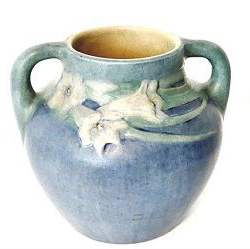
(via newcombartmuseum.tulane.edu)
In New Orleans during the late 19th and early 20th century, a form of artistic expression emerged. It emphasized improvisation and individual expression, and it gave voice to talented individuals whose voices had traditionally been repressed.
It’s not what you may think. As well as jazz music, that description can apply to Newcomb pottery.
A permanent display of Newcomb products in the new Commons building on Tulane’s Uptown campus now makes them more accessible to the general public as well as students.
Newcomb College formed in 1886 as the first degree-granting college for women in the South. Within a decade, the Newcomb Art School began producing pottery to be sold at a profit, providing an income for the artists it had trained, according to the Newcomb Art Museum website.

Students work on pots along with potter Joseph Meyer, right, around the turn of the 20th century. (via newcombartmuseum.tulane.edu)
Although the Newcomb shop was groundbreaking in employing women as designers and decorators, only male ceramicists threw the pots, as the wheel was considered unbecoming of a lady.
The pottery was part of the Arts and Crafts movement — emphasizing simple forms and exacting craftsmanship. Its artists and craftspeople believed in instilling beauty in everyday objects.
Early Newcomb designers favored a green-blue pallet, reflecting the delta, coast and marsh land. The themes were taken from the natural surroundings as well, using images that bring to mind a Louis Armstrong song: magnolias in bloom, moss-covered vines, tall sugar pines, moonlight on the bayou.

Floral motifs and green and blue glazes are hallmarks of early Newcomb works. (newcombpottery.com)
The Newcomb aesthetic and methods evolved over the years, and the enterprise struggled during the Depression. The college officially closed it down in 1940, but the works remained in production until 1952, when the major pottery instructor retired. By that time, sales had declined dramatically as mass-produced items gained popularity.
An estimated 71,000 total pieces of Newcomb pottery were produced over the decades, with the largest collection held at the Newcomb Art Museum. But not in its galleries. Space limitations mean that most of the pieces are in storage.
There are other places on campus, however, to learn about and enjoy Newcomb pottery.
To provide public access to the history and works of Newcomb Pottery, Newcomb Art Museum and Newcomb Institute have created a permanent exhibit space on the third floor of the new Commons building on Tulane’s Uptown campus that is free and open to the public.
Spanning more than 50 years, the display, “Newcomb Pottery Through the Years,” centers on the historical timeline of the pottery and the shifting style through the decades and features more than 70 rarely displayed treasures from the permanent collection.
They include Newcomb Pottery and other crafts that were taught in the school, including textiles, jewelry, metal objects and bookbinding. The miniature exhibition is accompanied by a free publication, “The (Feminist) Origins of Newcomb Pottery, written by art scholar Jenni Sorkin, which includes a timeline of the Newcomb Pottery, and additional images. The exhibit is free and open to the public.
Although the galleries don’t always display Newcomb pottery, the entry courtyard does. In the courtyard, Woodward Way, into the Newcomb Art Museum in the Woldenberg Art Center, surrounded by stunning Tiffany stained-glass windows, is a display of Newcomb pottery in glass vitrines that explores the various decorative techniques.
A third place to see Newcomb pottery is in The Goldring/Woldenberg Business Complex. Located on the opposite side of the Newcomb Quad, the A.B. Freeman School of Business’s Goldring/Woldenberg Business Complex has a small selection of pieces of Newcomb pottery and other select works from the collection. It’s free and open to the public.
If that’s not enough, you can take the Newcomb Collections Tour. The Newcomb Art Museum holds a free behind-the-scenes collections tour at noon on the first Friday of each month. To reserve a spot for this free tour, email spolisar@tulane.edu.
For additional information, email museum@tulane.edu or call 504-865-5328.